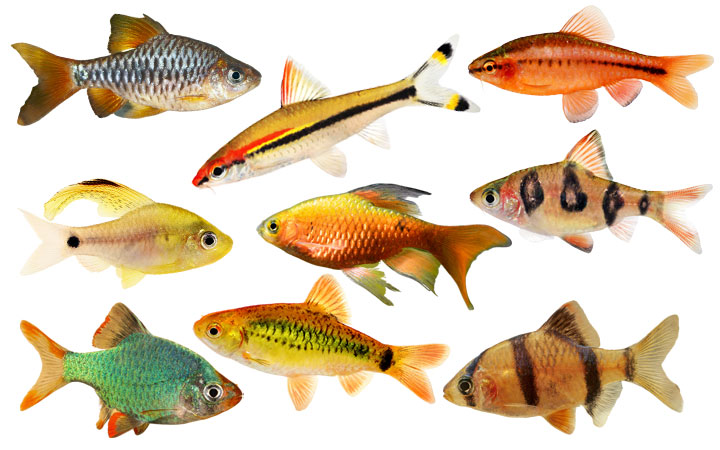
Barb fish are a popular choice for freshwater aquarium enthusiasts. Known for their vibrant colors and active behavior, these fish are relatively easy to care for and add a dynamic element to any tank. In this comprehensive guide, we’ll explore the most popular barb fish breeds, their care requirements, and tips for keeping them healthy and happy.
Understanding Barb Fish
Barbs belong to the family Cyprinidae, which includes over 2,000 species. Native to various regions in Africa and Asia, barbs are hardy fish that can adapt to a range of water conditions. They are often characterized by their elongated bodies and forked tails, with many species displaying striking color patterns.
Popular Barb Fish Breeds
1. **Tiger Barb (Puntius tetrazona)**
- **Appearance**: Distinctive black stripes on a silver or gold body.
- **Size**: Up to 3 inches.
- **Temperament**: Semi-aggressive; best kept in schools of at least six to minimize fin-nipping.
- **Tank Requirements**: 20 gallons minimum, with ample swimming space and hiding spots.
2. **Cherry Barb (Puntius titteya)**
- **Appearance**: Bright red coloration, more vivid in males.
- **Size**: Up to 2 inches.
- **Temperament**: Peaceful; suitable for community tanks.
- **Tank Requirements**: 15 gallons minimum, with plants for cover.
3. **Rosy Barb (Pethia conchonius)**
- **Appearance**: Rose-gold body with a hint of orange.
- **Size**: Up to 6 inches.
- **Temperament**: Peaceful; active swimmer.
- **Tank Requirements**: 30 gallons minimum, prefers cooler water temperatures.
4. **Gold Barb (Barbodes semifasciolatus)**
- **Appearance**: Golden-yellow body with metallic sheen.
- **Size**: Up to 3 inches.
- **Temperament**: Peaceful and social.
- **Tank Requirements**: 20 gallons minimum, enjoys a well-planted tank.
5. **Odessa Barb (Pethia padamya)**
- **Appearance**: Bright red stripes running along the body.
- **Size**: Up to 3 inches.
- **Temperament**: Peaceful; best kept in schools.
- **Tank Requirements**: 20 gallons minimum, prefers planted tanks.
General Care Tips for Barb Fish
Tank Setup
When setting up a tank for barbs, consider the following:
- **Tank Size**: Choose a tank size that accommodates the number of barbs you plan to keep. Larger tanks are better as they provide more swimming space and help maintain water quality.
- **Water Parameters**: Most barbs thrive in water with a pH between 6.0 and 7.5, and a temperature range of 74-79°F. Regular water testing and maintenance are essential.
- **Substrate and Decor**: Use fine gravel or sand substrate. Provide plenty of plants, rocks, and driftwood to mimic their natural habitat and offer hiding places.
Feeding
Barbs are omnivores and should be fed a varied diet:
- **Staple Diet**: High-quality flake or pellet food designed for tropical fish.
- **Supplemental Food**: Live or frozen foods like brine shrimp, bloodworms, and daphnia.
- **Vegetables**: Blanched peas, spinach, and zucchini can be offered occasionally.
Feed barbs small amounts 2-3 times a day, ensuring they consume all food within a few minutes to avoid overfeeding.
Behavior and Compatibility
Barbs are generally active and social, but their temperament can vary:
- **Schooling**: Most barbs prefer to be in groups of six or more. Keeping them in schools reduces stress and aggressive behavior.
- **Tank Mates**: Choose compatible tank mates like tetras, rasboras, and peaceful bottom dwellers. Avoid slow-moving or long-finned species that might become targets for fin-nipping.
Breeding Barb Fish
Breeding barbs in captivity is relatively straightforward:
1. **Sexing**: Males are usually more brightly colored and slimmer than females.
2. **Breeding Setup**: Use a separate breeding tank with a mesh or marbles at the bottom to protect eggs from being eaten.
3. **Spawning**: Condition the breeding pair with high-quality live foods. Barbs typically scatter eggs among plants.
4. **Egg Care**: Once eggs are laid, remove the adults to prevent them from eating the eggs. Eggs will hatch in 24-48 hours.
Common Health Issues and Prevention
Barbs are hardy, but they can be susceptible to common fish diseases:
- **Ich**: Look for white spots on the body and fins. Treat with increased temperature and medication.
- **Fin Rot**: Frayed or decaying fins indicate this bacterial infection. Maintain good water quality and use antibacterial treatments.
- **Swim Bladder Disease**: Causes difficulty in swimming. Often due to overfeeding or poor diet. Feed peas to help relieve the condition.
Preventative Measures
- **Quarantine New Fish**: Always quarantine new fish for at least two weeks before adding them to the main tank.
- **Regular Maintenance**: Perform weekly water changes (25-30%) and clean the tank regularly to keep water parameters stable.
- **Diet**: Provide a balanced diet to ensure your barbs receive all necessary nutrients.
Conclusion
Barb fish are an excellent choice for both novice and experienced aquarists. With their vibrant colors and lively behavior, they can be a standout feature in any freshwater aquarium. By understanding the specific needs of different barb species and providing appropriate care, you can enjoy the beauty and activity these fish bring to your home for years to come.
Whether you’re interested in the striking Tiger Barb, the peaceful Cherry Barb, or the vibrant Odessa Barb, there’s a barb fish breed to suit every aquarium enthusiast. Remember to maintain proper tank conditions, feed a varied diet, and monitor their health regularly to ensure your barbs thrive in their aquatic home.


